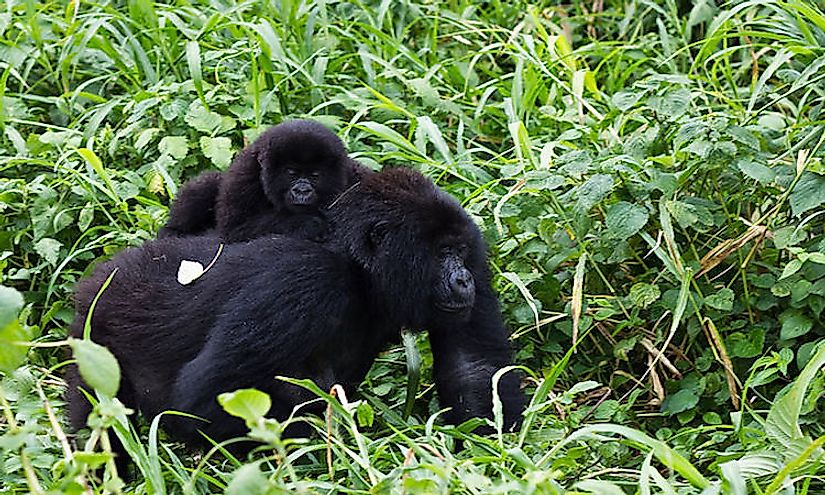National Parks Of The Democratic Republic Of The Congo

The DR Congo has some of the largest, most ecologically significant, and most endangered nature reserves on earth. With its vast savannahs, grasslands, rainforests, and woodlands, the country provides refuge to some of the critically endangered species on the planet. The country also has the largest tropical rainforest reserve. The Virunga National Park has the biggest population of mammals, birds, and reptiles in Africa. The northern white rhinoceros, almost extinct, finds a home in the Garamba National Park. Despite the weak economy, and the civil wars that nearly annihilated endemic species, the National Parks of the DRC have provided a Sanctuary to many plant and animal species.
Garamba National Park
The Garamba National Park is a land of grasslands, savannahs, and woodlands, interspersed with forests along the river banks, and swampy depressions lying between the Condo Basin and the Guinea-Sudan savannahs in a 4,920 square kilometers area. The park is home to the white rhinoceros, elephant, giraffe, and hippopotamus; the "big four" mammals. The parks provide refuge to the endemic subspecies of the Congolese giraffe, last remaining populations of the northern white rhinoceros, and the mixed population of forest elephants and bush elephants. It also home to the purely savannah lion species, the spotted hyena, many antelopes, bongo, hogs, chimpanzee, and the small diurnal primates. The Congolese Institute for Nature Conservation manages the National Park.
Kahuzi-Biega
Kahuzi Biega National Park, located in Bukavu town of the DRC has the mountainous and lowland terrain. With an area of about 6,000 square kilometers, and stretching from the Congo Basin to the Albertine Rift, Kahuzi-Biega is one of the largest National parks in the DRC. It provides a home to the endangered species of the Eastern Lowland Gorilla, (Gorilla beringei graueri). It also provides habitats to the Chimpanzee, colubus bai, Cercopithecus of Hoest and Hamlyn, the giant forest genet (Genetta victoriae) and (Genetta piscivora), the aquatic genet. The wet equatorial rainforests lie to the west; and the mountainous eastern region has continuous forests vegetation and also contains six distinct vegetation types; swamp forests, swamp, and peat bog, bamboo rainforests, high altitude rainforests and subalpine heather.
Virunga National Park
The Virunga National Park covers an area of 7,800 square kilometers stretching from the Virunga mountains to the Ruwenzori Mountains of Eastern DRC. The northern sector of the park has lake shores, African savannahs, Riverine forests, alpine forest, and eternal snow. The central region has African savannah, marshland Riverine forests, and the lake shores. In the southern sector, the old lava flows are still evident amidst alpine forests and Montane Tropical Forests. The park is home to the biggest bird, mammal, and reptile populations in a protected area in Africa. Mountain gorillas, savannah and forests elephants, Chimpanzee, lowland gorillas, okapi, giraffes, buffaloes, and endemic birds live here. During the civil wars in the country, the park suffered intense poaching and land invasion that ruined its vegetation and endemic fauna. However, the last three years has seen the park regenerate, and tourism develop. The Virunga Foundation manages and protects the park from imminent invasion and excessive poaching that is driving the mountain gorillas and chimpanzee almost to extinction.
Salonga National Park
The Salonga National Park located in the Congo River Basin is the Largest Tropical Rainforests reserve in Africa covering approximately 36,000 square kilometers. It runs from the provinces of Kasai oriental, Kasai Occidental, Equateur, and Bandundu. It houses a broad range of animals like the bonobos, Dryas monkeys, Congo Peacock, leopards, African slender-snouted crocodiles, long-tailed pangolin, Angolan slender mongoose African golden cat, Okapi, Bushbuck and much more. Birds’ species include the cattle egret, yellow billed stork, and black stork. Vegetation includes the vast rainforests, marshland areas, and gallery forests. Like other parks in the DR Congo, poaching and vegetation removal by the locals is the primary threat facing these ecosystems. The Management Authority of Congolese Institute for Nature Conservation manages the park.
The Congolese Institute for Nature Conservation manages most of the national parks in DR Congo. Also, the locals are involved in the management plan which is advisable because only the people living in these areas can protect them from illegal poaching. Even though the civil wars in Congo invaded and almost destroyed some of the unique vegetation and endemic plant species in the forests, the national parks still retain a vastness and uniqueness found nowhere else in the world.
National Parks Of The Democratic Republic Of The Congo
| National Parks of the Democratic Republic of the Congo | Area |
|---|---|
| Garamba | 4,920 square kilometers |
| Kahuzi-Biéga | 6,000 square kilometers |
| Kundelungu | 7,600 square kilometers |
| Maiko | 10,885 square kilometers |
| Mangroves-Muanda Marine | 768 square kilometers |
| Okapi | 13,726 square kilometers |
| Salonga | 36,000 square kilometers |
| Upemba | 11,730 square kilometers |
| Virunga | 7,800 square kilometers |











